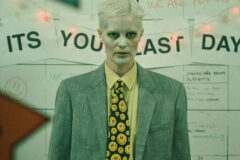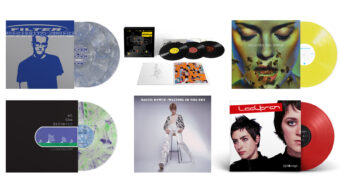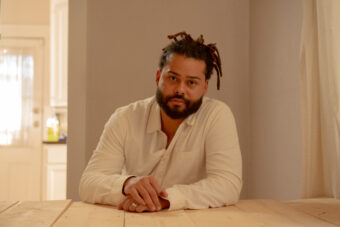In a preparatory manifesto that presaged the release of their new album, the Knife tried to set some terms: “We have a bellyache, a big stink, a major grouse or two with manufactured knowledge. But how do you build an album about not knowing?”
The Swedish duo’s monumental new album, Shaking the Habitual, is a 98-minute, double-CD release that runs from fourth-world futurist techno to sprawling studies in electro-acoustic soundscaping, as abstract as Continental philosophy. So clearly, not knowing is the way to go — this is the most visceral, exhilarating music they’ve ever made, a riot of unstable dance-floor rhythms and mutating sound design that pulls together the best aspects of their previous work and hurtles it so far into the distance that artist and listener alike are left struggling to catch up. Or maybe not “struggling,” because Shaking the Habitual, out April 9, is deeply invested in the pleasure that comes when you stop making sense. The record thrums with libidinal energies and animal instincts as well as mutable electronic frequencies; informed by the duo’s readings in feminist and queer theory, it questions the nature of identity with every digitally processed snarl, and it upsets neat binary oppositions with slippery tunings that merrily flip the bird at Pythagoras and his well-tempered scale.
But how do you talk about an album about not knowing? That part is harder. If you are the Knife’s Karin Dreijer-Anderson and Olof Dreijer, you choose your words carefully. Where the new album’s lyrics are a minefield of super-charged language — “a screaming hand,” “the cock had it coming,” “the piss is territorial” — the sister-brother duo pick their terms with almost clinical precision when we speak via Skype. (Of course, that could be due to language barriers and fiber-optic latency. “It’s a privilege to make an album, to move freely,” they note in the aforementioned introductory text, but communication across great distances nonetheless remains a pain in the ass.) Or perhaps they’re simply not interested in pinning down the edges of their unruly music. As Dreijer-Andersson sings on “Full of Fire,” “Questions and the answer can take very long / Here’s a story / What’s your opinion?”
You’ve said that you weren’t sure you were even going to make another Knife album. When did you begin working on Shaking the Habitual, and how did it come together?
Karin: “I think it’s about three years ago, when we started to talk about it. We were mostly talking about if we were going to do something together, what could that be. We were talking about what kind of music and ideas we were into, so I think we wanted to find a common ground for working. It seemed like a good idea to combine our other interests, like political interests, with making music. Also, we wanted to read more and learn more theory.”
You talked about reading theorists like Judith Butler. What kind of ideas in that sort of writing helped inspire the record?
Karin: “It’s so many different things that we have been discussing during these years, so it’s really hard to just talk about a few. For example, authenticity. That’s something that I think we have been coming back to a lot. It pops up in many different situations. Like the idea of authenticity, the idea of some kinds of music being more ‘real’ and ‘serious’ and ‘quality,’ than other kinds of music. That’s something that we have been reading about and talking about.”
Olof: “I guess the feminist and queer theory that we’ve been reading and studying over the last few years has helped us understand what we formerly felt, and find the words to understand political structures. This is spoken about in the lyrics. I think the lyrics are one thing, and the music is another thing, where we deal more with playing around with ideas around authenticity and artistic quality and these different norms that are around us. It may sound messy, but it’s so many things at the same time.”
You talked about the importance of collective work and finding a community with this record, and you brought on many collaborators —Jess Arndt, Roxy Farhat, Marit Östberg, Shannon Funchess, Emily Roysdon, and others. Would you say that the Knife is bigger than just you two at this point?
Karin: “I hope so.”
Olof: “We just wanted to have a lot more fun and engage people we know and people we don’t know, just involve all these people that share similar political practices.”
Karin: “It’s such a good way to get inspired, to be able to hang out with these people and discuss things and learn more. That’s something that I have learned during this process, too — the way feminist activists work, or the queer communities that I have gotten to know a little bit in Berlin, for example. It’s so inspiring to see how you can work and create your own autonomous collective, where you can work with your ideas without having to struggle with other forces around you. To create these spaces where you can work more safely with your ideas. I think that has been really good for us.”
In an interview a few years ago, Olof described 2006’s Silent Shout as a record intended to affect people emotionally, whereas 2003’s Deep Cuts aimed to raise political awareness. Where does Shaking the Habitual fall on this spectrum between the expressive and the political?
Olof: “I don’t know, maybe it’s too early to say now. Maybe it’s easier to say that in a year or so. With this record, one big difference is that many of the pieces are really studies. We wanted to learn something, we wanted to dive into a field that we were not so familiar with. We also built an instrument, or someone built us an instrument, and we really learned that, and some of the songs are results of that learning process. Also, we wanted to learn how to play around with alternative tuning and also really go into trying to figure out how to represent all this great literature that we had read. It’s a lot of investigating and having fun and learning.”
Were you together when you made the record, or were you sending ideas back and forth between Stockholm and Berlin?
Olof: “We were working a lot separately, and then we got together and looked at what we had done and worked together. So I think it was a bit of both.”
Karin: “I have my studio in Stockholm, and Olof has his studio in Berlin, so we have been working in both places.”
There’s a reference to an instrument made out of bedsprings in the text. Could you tell me more about that?
Olof: “It was just a bedspring. [Laughs] It’s not so exciting. It’s really just an old bedspring in a box.”
Karin: “In a wooden box, and you play it with a bow, as you’d use for violins.”
Olof: “We just had this long list of ideas and ways to work that we wanted to try out, and we maybe went through half of it or less. We wanted to make feedback with a PA in a boiler room, like a huge room. We did that. And we wanted to investigate what a protest song of today could be, a protest song that can have different perspectives on an issue rather than delivering one answer.”
Karin: “But we never had any idea of a style or something. We just had this long list of things that we wanted to try out. I guess it’s in the mixing process, when you’re done with all the music, you try to fit them together more. When you do the track list and when you do the mixing — we mixed everything through the same mixing desk, so I guess that’s something you do in the end, like trying to get it to fit together in a way.”
“Old Dreams Waiting to Be Realized” reminded me a little bit of the Swedish electro-acoustic composers Ake Hodell and Folke Rabe. I don’t know if that was a coincidence.
Karin: “Yes, I’ve been listening to a record from Kning Disk, who put out a Folke Rabe record a while ago. We have both been interested in electro-acoustic things as well. Many years ago I started to study electro-acoustics at school in Stockholm. There is definitely that kind of experimenting also.”
The album’s “Old Dreams” creates a strong contrast with the more rhythmic material on the album. It’s long, it’s quiet, you need to turn up the volume for it — it’s really the opposite of the way people listen to music on YouTube and their phones. In a video interview you said that it was important “to make music that demands people’s time and consciousness.”
Olof: “I don’t know what to say other than that we’re very driven by curiosity and we wanted to have fun and learn more things. Then, in the process of selecting what tracks and what things can actually end up on the record, come the conceptual ideas and the political ideas. And what you just said, from that interview text, is the reason why in the end we let it be there on the record. I think also it’s nice to believe in the listener, that many people are open and into getting something more out of things.”
You said that the lyrics were inspired by political hymns from the 1970s. Was politics a part of your childhoods, growing up?
Olof: “Yeah, we grew up with a radical-left discussion at home. We were listening to progressive rock bands or theater music that was dealing with issues like, workers’ rights and workers’ history, international solidarity.”
Would you say that Sweden is generally more progressive than other parts of Europe?
Olof: “I think there’s a mainstream discourse that is at maybe a level where you can talk about things, and many great queer/feminist writers are active on the mainstream level, and you read their texts in the tabloid evening newspaper. That is really great. But it becomes obvious that they have to take a lot of hatred, because the actual situation I don’t think is so great.”
Karin: “The political parties have tried to do a lot of things for equality, but I don’t think it works so well in practice. There are a lot of laws and ideas and possibilities for being more equal. I still think, in practice, there’s so much left to do, or to realize.”
Olof, I understand that as Oni Ayhun, you only perform at events where there is gender parity on the lineup. Will you extend that to the Knife’s bookings?
Olof: “With my solo project, I’ve been using the approach that I only perform at nights or festivals that have no more than 50% people who identify as men. Now that we go on tour with the Knife, we are on a completely different level. We have gone about it a bit differently. We’ve asked for statistics and figures on this and last year’s representation of men and women onstage, and together we can kind of get a picture of how things are. What we will do with that, we haven’t really decided. We do take it into consideration, but we haven’t been that strict — I mean, if we were to use that policy as I did before, we wouldn’t play at one single festival. That’s what happened with my solo project, I could only do single nights where there were three or four artists, and I could be part of selecting the other ones. At festivals, the average is around like 80/20, sometimes worse, sometimes a bit better.”
Karin: “We have asked how they look upon these things, and if they have a strategy or an idea for booking equally between female and male artists. I think it’s good to have their answers. If you compare festivals, it’s good to know what kind of bookings they do.”
Olof: “We also wanted to see what vocabulary people used, and see how many people use words like ‘quality’ before ‘gender,’ for instance. When people talk about that, when they believe in steady words like ‘good’ and ‘bad’ music, then it’s really difficult to move on. There are so many discussions that need to be had at the same time. We also ask about having generally increased pluralism in general, like if they think about nationality and what type of music people play. It’s so many things.”
You’ve spoken before about the sense of humor in your music; where do you see that coming out in the new album?
Karin: “We decided when we started that it had to be a fun process. [Laughs] I think we kind of made it a fun process. Even if you deal with very sad issues and how things work around you, I think it can be dealt with, I think it’s very important — you have to get energy from somewhere. I think also, working on the live show that we have been doing for the last year, that’s also something that we have been talking about a lot. It has to be fun, and we should enjoy the process. I think we will show some humor in our live show.”
Plus, you sing about “a handful of elf pee.”
Karin: “That can be fun.”
Who created the cover art and the pink-and-green color scheme? It reminded me a little of old Stereolab covers.
Karin: “Ah! The comics are done by Liv Strömqvist, who has been making very feminist and socialist political comics in Sweden for a few years. The artwork, the colors, it’s a friend of ours, Martin Falk, who made the artwork. How did we end up with the colors?”
Olof: “I mean, we just wanted something that feels, as always, I guess.”
Karin: “It’s a little bit itchy. It’s not really comforting to look at these colors together, and I think that’s really nice. We actually got the physical CD today. It’s released in Sweden tomorrow, and it’s really glossy as well. So it’s this magenta —”
Olof: “Party.”
Karin: “Magenta party artwork. It feels cheap and very glossy at the same time. It’s such a nice contrast.”
You discuss the “5 a.m. warehouse beat” in your text. Can you talk about the influence of dance music on the album? In the video for “A Tooth for an Eye,” the lighting in the gymnasium even reminded me of the windows at Berlin’s Panorama Bar, where I saw Olof play as Oni Ayhun a few years ago.
Olof: “I think that is accidental. But it’s nice.”
Karin: “Something we agreed was that if we activate our bodies with dance, we will think much better, and we will learn so much more from what we read. That was something we agreed upon, that it has to be really dancey. I didn’t want to do a tour like Fever Ray once more, where you just stand still and sing. [Laughs] That was definitely something we had on our list, to be able to dance a lot.”
What else can you tell me about the new live show?
Karin: [Hums]
Olof: “It’s going to be so much more fun for everybody to see it if they don’t know anything. We could again go on talking about process. We involved a really nice group of people who have a norm-critical approach in what they do, like choreographers, scenographers, and so on. We just put together quite a big group of people that everybody worked together with putting together the show as a collective, and we think and sketch together, very collectively. And have fun.”





